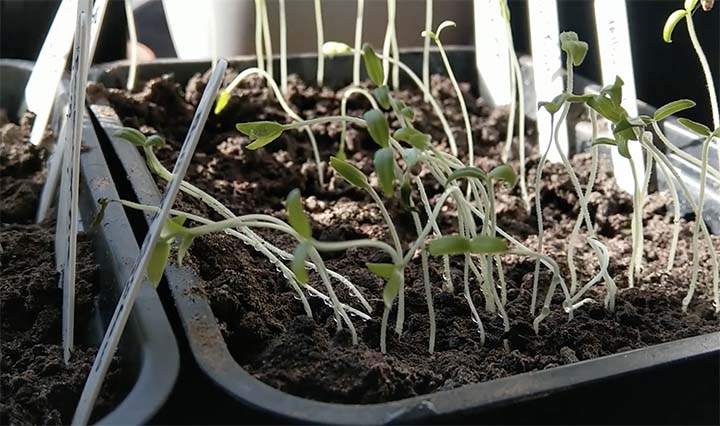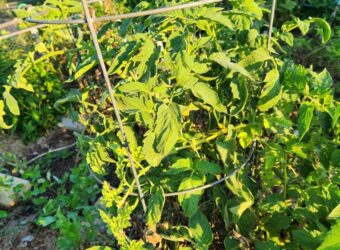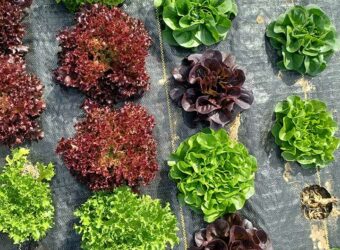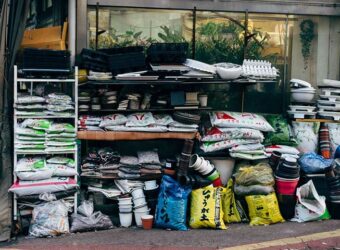Tomato plants are fun and easy to grow. There are some things to be careful about when growing them. This guide talks about leggy tomatoes, how to avoid them, and how to deal with them.
Leggy Tomato Seedlings Versus Normal Tomato Seedlings
Tomato seedlings should be short and stocky. Seedlings should have the diameter of a pencil and be under a foot tall when transplanted into the soil. If seedlings do not get enough light, they will stretch toward the light and be thin and tall. These leggy seedlings are weaker than normal seedlings and start off at a disadvantage. Don’t buy leggy seedlings.
How Do I Fix Leggy Tomato Seedlings?
Once a seedling becomes leggy, you cannot fix it. You can only support the seedling with a stake until planting.
How Do I Prevent Leggy Tomato Seedlings?
Leggy seedlings are caused by two things: low light and too much fertilizer.
The best way to prevent leggy seedlings is to grow them under a grow light. Place the light about two to four inches over the seedlings. As the tomato seedlings grow, adjust the lights, so they stay two to four inches above the top of the seedlings. A shop light on a chain works well, or a grow light on a chain.
Over-fertilizing seedlings cause them to grow too fast, and they will stretch out, especially in low-light conditions. To fertilize your seedlings, mix a fish emulsion fertilizer at half-strength. I use it in place of water once a week after the seedlings have two true leaves.
How Do I Plant Leggy Tomato Seedlings?
Transplanting leggy tomato seedlings requires a little more work but can fix the leggedness if done right.
- Dig a hole for the root ball that is an inch deeper than the root ball.
- Dig a shallow trench angling from the hole to the surface of the soil.
- Place the root ball in the hole on its side.
- Lay the tomato seedling in the trench with the top four inches above the ground.
- Remove the leaves from the part of the stem that will be underground.
- Cover the root ball and stem with the soil.
- Water in the tomato seedling.
- Install the stake or cage to support the tomato plant now.
The seedling will turn upwards as it grows and develop normally.
Notes On Growing Healthy Tomatoes
The work doesn’t stop once you plant your tomato seedling. Here are some ways to make sure it grows well and produces lots of tomatoes.
Before Transplanting
- Pick a place that gets at least six hours of sun. If you live in a hot climate, afternoon shade will help keep the plant from getting too hot.
- Do not plant your tomato plants where tomatoes, potatoes, or other deadly nightshade crops have grown in the past three years. Diseases and pests will overwinter and stay in the soil for two years or more and will attack your tomato plants.
- Till the soil bed to a depth of six inches. Spread three inches of compost on the soil and work them into the top six inches of soil. Do not use manure, as it carries diseases that can make you sick.
- Do a soil test about three weeks before planting your tomato seedlings. Fertilize the row according to the recommendations on the soil test results. Water the area well to release the fertilizer into the soil.
- Do not plant your tomato seedlings until all danger of frost has passed and the soil has warmed.
- Make a ridge about six inches high on your row. Plant your tomatoes in the ridge
- Space determinate tomato plants two feet apart and indeterminate tomato plants three feet apart. Read our article for the correct tomato plant spacing.
- Place rows three feet apart.
- Both determinate and indeterminate plants grow better and have more tomatoes when caged or staked. Indeterminate plants must be caged or staked.
After Planting
- Tomato plants use a lot of water. Water the seedlings every day for a week, then water them every three days for a week. After that, water an inch a week. If your climate is hot, you may need to water twice a week. Your goal is to keep the soil evenly moist. Dry soil or wet soil will cause problems. Fluctuations in soil moisture are a key cause of blossom end rot.
- Fertilize with a fertilizer formulated for tomatoes. Follow the instructions on the label for the amount of fertilizer and the frequency of fertilization. Too much fertilizer will cause your tomato plants to grow too much and not put on as many blooms and tomatoes. In extreme cases, the fertilizer can burn the roots and leaves and kill the tomato plant. You will need to start fertilizing when the plants start blooming.
- After planting your seedlings, place three inches of mulch around them. Do not let the mulch touch the stems. Mulch helps keep the soil moisture even and helps keep weeds out of your tomato patch.
- Keep weeds under control. Not only do weeds steal moisture, nutrients, and sunlight from your tomato plants, they harbor pests that can damage your tomato plants and fruit.
- Tomatoes attract many pests. Most can be picked off of the tomato plant and dropped into a jar of soapy water to drown. Caterpillars can be treated with Bacillus thuringiensi (Bt). Bt is allowed in organic gardening. Other pests can be controlled with pyrethrins, which are also allowed in organic gardening. Pyrethrins will also kill bees and other beneficial insects, so avoid using them if possible.
- Harvest tomatoes when they are completely ripe. If you harvest a tomato that is not quite ripe, leave it on the counter to ripen. Do not place tomatoes in the refrigerator unless they are fully ripened.
In conclusion, the most common cause of leggy tomatoes is too little light. These seedlings are tall, thin, and weak. While you cannot fix a leggy tomato, you can help it by the way you transplant the seedling. To prevent leggy tomatoes, provide enough light and do not over-fertilize the seedlings.






